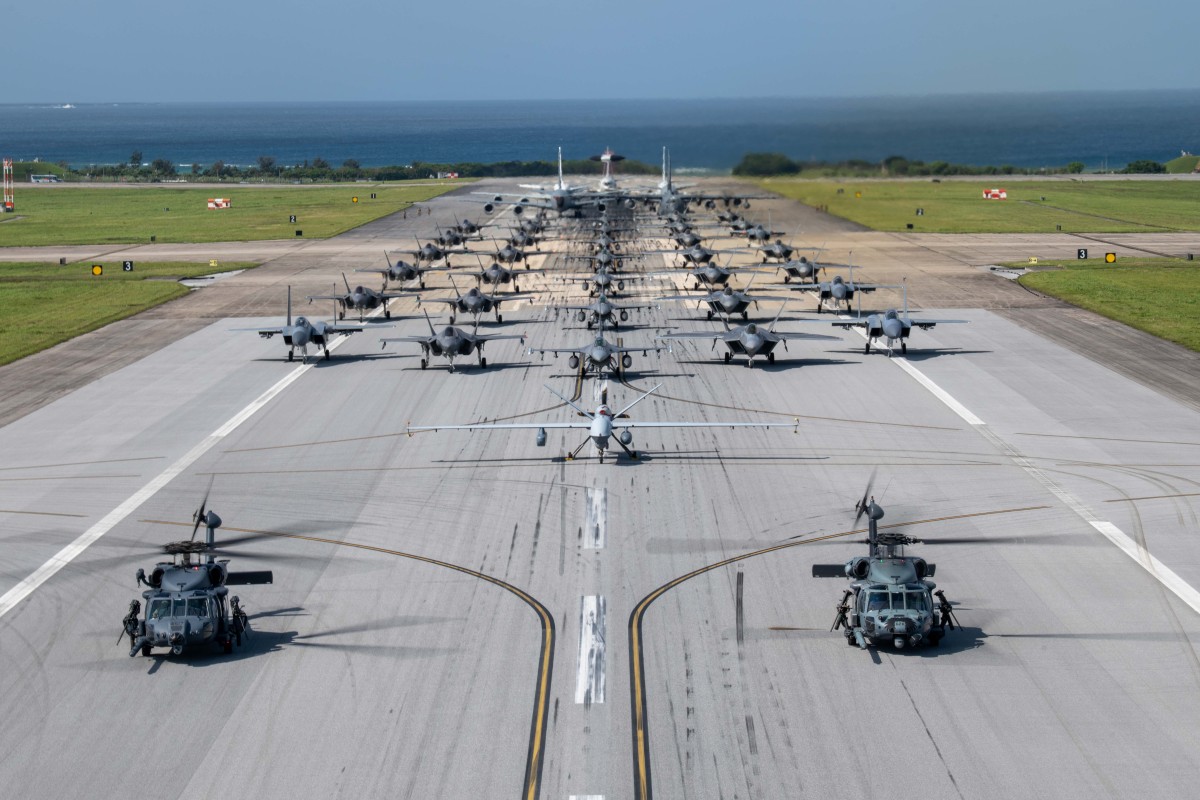In a striking display of air power and operational readiness, the US Air Force and Navy carried out a spectacular “elephant walk” at Kadena Air Base in Japan’s Okinawa Prefecture on April 10, 2024.
The “elephant walk” (taxiing of military aircraft right before takeoff) event showcased a formidable lineup of aircraft, underlining America’s commitment to ensuring “a free and open Indo-Pacific region.”
The elephant walk served as a powerful symbol of the strength and preparedness of the US Air Force and Navy, showcasing their ability to rapidly deploy a wide range of aircraft to support missions across the region.
The US Air Force announced this grand display in a press release titled “Raptors and Vipers join the flock,” issued on April 11.
It highlighted the participation of the Air Force’s largest combat wing and its mission partners, who brought forth an impressive array of some of the most advanced aircraft in the world.
The lineup featured the F-15C, F-16C, F-22A, F-35A, MQ-9, HH-60G/W, MC-130J, KC-135, P-8, RC-135, and E-3. This diverse assembly of air power symbolized the US military’s readiness and capability to undertake any air combat mission in the region.

The gathering of these advanced aircraft coincided with the arrival of new rotational units, which introduced F-16Cs and F-22As to Kadena Air Base. This reinforcement underscores the strategic significance of Kadena as the “Keystone of the Pacific,” serving as a pivotal hub for US air operations in the region.
Amidst the arrival of new assets, the US also bid farewell to its F-35As and Air National Guard F-15Cs. These aircraft, which have safeguarded regional security, are now making way for newer capabilities and rotations.
Following the elephant walk, the aircrew immediately launched a large-force exercise aimed at enhancing their readiness to defend Japan. Such exercises are vital to ensuring that military personnel are well-prepared to respond to any potential threats or contingencies effectively.
Keystone Of The Pacific
Kadena Air Base holds a strategic position as the only major US air base within the unrefueled range of the Taiwan Strait.
This geographical significance renders it a prime target for China’s long-range missiles in the event of a Taiwan contingency. The presence of such a threat heightens the need for continuous vigilance and preparedness among the personnel stationed at Kadena Air Base.
Kadena Air Base recently welcomed two F-22 Raptor squadrons — the 199th and 99th Fighter Squadrons — on March 28, bolstering the base’s fifth-generation airpower capabilities.
These squadrons have joined other fighters already deployed at Kadena, contributing to a total of more than 100 aircraft stationed there, either on deployment or permanently. This diverse fleet performs a wide range of functions, highlighting Kadena’s significance as a strategic hub for air operations in the region.
Nonetheless, the introduction of the F-22 Raptors marks the latest step in a series of aircraft rotations at Kadena, driven by the phased retirement of the base’s aging F-15C/D fleet.

The Defense Department announced plans in December 2022 to retire or reassign two squadrons of these aging F-15 aircraft, which have been in operation at Kadena since 1979.
As the Air Force decides on a permanent replacement, it continues to rotate fighter squadrons through Kadena, recognizing its pivotal role as the “keystone of the Pacific,” strategically located near Taiwan and the East and South China seas.
Various fighter squadrons, including F-16CM Fighting Falcons, F-35A Lightning IIs, F-15Cs, and F-15E Strike Eagles, have taken turns operating from Kadena’s flight line in recent times.
While there have been no official announcements regarding a new permanent fighter presence at Okinawa, reports have surfaced suggesting plans for a smaller number of advanced F-15EX fighters at Kadena.
Some concerns, however, have been raised regarding the proposed replacement ratio, with Rep. Rob Wittman earlier expressing the need for an operational analysis to support the decision.
The US Air Force stated that the Defense Department maintained a steady-state presence at Kadena by deploying newer and more advanced aircraft to compensate for the phased-out F-15C/Ds of the 44th and 67th Fighter Squadrons previously stationed there.
This approach ensures that Kadena remains ready with modern capabilities to fulfill its strategic objectives effectively.
- Contact the author at ashishmichel(at)gmail.com
- Follow EurAsian Times on Google News




